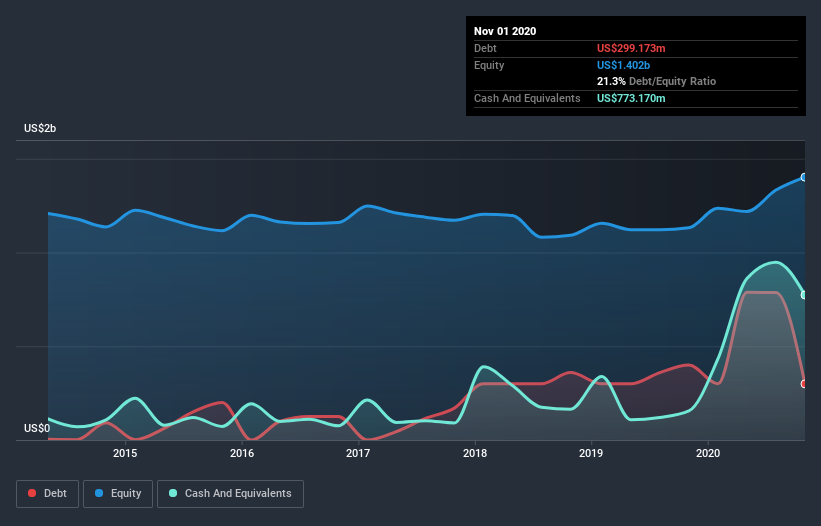Williams-Sonoma (NYSE:WSM) Seems To Use Debt Rather Sparingly
David Iben put it well when he said, 'Volatility is not a risk we care about. What we care about is avoiding the permanent loss of capital.' It's only natural to consider a company's balance sheet when you examine how risky it is, since debt is often involved when a business collapses. Importantly, Williams-Sonoma, Inc. (NYSE:WSM) does carry debt. But should shareholders be worried about its use of debt?
When Is Debt A Problem?
Debt and other liabilities become risky for a business when it cannot easily fulfill those obligations, either with free cash flow or by raising capital at an attractive price. Part and parcel of capitalism is the process of 'creative destruction' where failed businesses are mercilessly liquidated by their bankers. While that is not too common, we often do see indebted companies permanently diluting shareholders because lenders force them to raise capital at a distressed price. Of course, plenty of companies use debt to fund growth, without any negative consequences. When we think about a company's use of debt, we first look at cash and debt together.
See our latest analysis for Williams-Sonoma
What Is Williams-Sonoma's Debt?
The image below, which you can click on for greater detail, shows that Williams-Sonoma had debt of US$299.2m at the end of November 2020, a reduction from US$399.8m over a year. However, it does have US$773.2m in cash offsetting this, leading to net cash of US$474.0m.
How Healthy Is Williams-Sonoma's Balance Sheet?
Zooming in on the latest balance sheet data, we can see that Williams-Sonoma had liabilities of US$1.46b due within 12 months and liabilities of US$1.45b due beyond that. Offsetting these obligations, it had cash of US$773.2m as well as receivables valued at US$129.8m due within 12 months. So its liabilities outweigh the sum of its cash and (near-term) receivables by US$2.01b.
Williams-Sonoma has a market capitalization of US$9.94b, so it could very likely raise cash to ameliorate its balance sheet, if the need arose. But it's clear that we should definitely closely examine whether it can manage its debt without dilution. While it does have liabilities worth noting, Williams-Sonoma also has more cash than debt, so we're pretty confident it can manage its debt safely.
On top of that, Williams-Sonoma grew its EBIT by 58% over the last twelve months, and that growth will make it easier to handle its debt. The balance sheet is clearly the area to focus on when you are analysing debt. But it is future earnings, more than anything, that will determine Williams-Sonoma's ability to maintain a healthy balance sheet going forward. So if you want to see what the professionals think, you might find this free report on analyst profit forecasts to be interesting.
Finally, a business needs free cash flow to pay off debt; accounting profits just don't cut it. Williams-Sonoma may have net cash on the balance sheet, but it is still interesting to look at how well the business converts its earnings before interest and tax (EBIT) to free cash flow, because that will influence both its need for, and its capacity to manage debt. Happily for any shareholders, Williams-Sonoma actually produced more free cash flow than EBIT over the last three years. That sort of strong cash conversion gets us as excited as the crowd when the beat drops at a Daft Punk concert.
Summing up
While Williams-Sonoma does have more liabilities than liquid assets, it also has net cash of US$474.0m. And it impressed us with free cash flow of US$1.1b, being 105% of its EBIT. So we don't think Williams-Sonoma's use of debt is risky. The balance sheet is clearly the area to focus on when you are analysing debt. However, not all investment risk resides within the balance sheet - far from it. To that end, you should be aware of the 1 warning sign we've spotted with Williams-Sonoma .
At the end of the day, it's often better to focus on companies that are free from net debt. You can access our special list of such companies (all with a track record of profit growth). It's free.
This article by Simply Wall St is general in nature. It does not constitute a recommendation to buy or sell any stock, and does not take account of your objectives, or your financial situation. We aim to bring you long-term focused analysis driven by fundamental data. Note that our analysis may not factor in the latest price-sensitive company announcements or qualitative material. Simply Wall St has no position in any stocks mentioned.
Have feedback on this article? Concerned about the content? Get in touch with us directly. Alternatively, email editorial-team (at) simplywallst.com.

 Yahoo Finance
Yahoo Finance 
